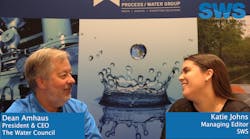Leslie Nemo is a freelance science writer based in the U.S. You can find more of her work on Twitter @leslie_nemo or on her website www.leslienemo.com. Nemo can be reached at [email protected].
A new paper out in the journal Water Research dives into the per- and polyfluoralkyl substances, known as PFAS, profiles of rainwater falling across several sites in the midwest.
“The one sentence takeaway: PFAS is everywhere,” said Kyndalanne Pike, a chemist at the University of Wisconsin-Madison. More specifically, results showed the urban water samples held the highest levels of the chemicals. The findings also left the team wondering how PFAS phased out of production in the U.S. are still circulating in our water systems.
Pike and her colleagues are at least the third team of scientists to assess U.S. rainwater for PFAS. The two other research groups collected their data just before and after the early 2000s phase out program, when producers in the U.S. voluntarily gave up making two kinds of PFAS — PFOA and PFOS. Pike and her colleagues wanted to know if the manufacturing pause resulted in lower levels of those two PFASs in today’s rainwater.
Rainwater Results
With help from citizen scientists, the group collected water samples across six sites in Illinois and Indiana, with Wooster, Indiana add state here for clarity serving as the urban location. A seventh collection in Jackson Hole, Wyoming, represented rainwater falling outside the Midwest.
That PFAS showed up in every water sample doesn’t surprise Norma Villagómez-Márquez. An environmental scientist at the University of Arizona, Villagómez-Márquez, who is unaffiliated with the new research, has been studying rainwater in at-home collection systems for contaminants, including PFAS.
“They're so ubiquitous in nature,” she said.
PFAS levels were particularly high in the Wooster rainwater. Concentrations of one PFAS variety, for example, were between seven and 54 times greater in the urban samples than in rain from other locations. Pike said she thinks regional manufacturing might explain the difference. Though suburban sites like Shaker Heights, Ohio, have similar population densities as Wooster, PFAS levels were significantly lower in these other locations. In Wooster, however, roughly 10% of city residents work in manufacturing.
Other study results are harder to draw conclusions for. Pike and her team found the samples held levels of phased-out PFAS at levels similar to what other researchers found in rainwater in the late 1990s and early 2000s. The endurance of outdated PFAS is something other researchers like Barbara Turpin, an environmental engineer at the University of North Carolina at Chapel Hill, have noticed recently, too. In an analysis of airborne particles across North Carolina, PFOS and PFOA were the most common PFAS.
“You might say that's surprising, right? Because those compounds were phased out around 2000 in the U.S.,” said Turpin, who is not involved with Pike’s research. However, “there are a few different ways that can happen.” PFOA and PFOS might be constantly replenished via imported products from countries that haven’t banned production. Some newer PFAS varieties in the U.S. degrade into byproducts that essentially are the phased-out chemicals. It’s also possible that residual PFOA and PFOS made in the U.S. are intact and circulating through the air, water and soil. Knowing which factor (or factors) is responsible is something worth exploring further, Pike said.
Pike and her team also found that overall PFAS levels in non-Wooster locations — meaning suburban, rural and even the remote Jackson Hole samples — showed similar concentrations of the chemicals. PFAS likely travel large distances: The chemicals appear in the Arctic and Antarctic, where no production facility exists. And in North Carolina, examinations of residential wells near a plant producing one of the latest PFAS varieties found that the chemical appeared at the highest concentrations in water downwind of the facility. But if weather patterns played into how PFAS levels in rainwater spread across the Midwest, Pike can’t say. She and her team didn’t include wind or storm movement analysis.
Experts anticipate tracing the paths of exact PFAS varieties will get easier. Depending on the manufacturing processes, a PFAS producer churns out the chemicals in different configurations and ratios, with some versions being more dominant in one PFAS source over another, Turpin explains. Chemists are expanding and fine tuning “fingerprinting” methods that trace an isolated PFAS — say, one found in rainwater — to specific production settings to identify how much of the PFAS in a location comes from each kind of source. The more confidence an analysis team has about the origin of a PFAS, the better policies can be crafted to reach intended results, Pike said.
RELATED: DROPPING BY #40: DIVING IN TO RAINWATER HARVESTING
Villagómez-Márquez also anticipates PFAS tracing to become easier once the Toxic Release Inventory begins recording the chemical. The EPA program requires industrial facilities to disclose how much of a given list of chemicals they release into air, water or land. In July, the first reports to include PFAS are due.
“That’s something I’m very excited about,” said Villagómez-Márquez. “If concentrations of these compounds are higher, we will be able to attribute it directly to the industrial and federal facilities.”






